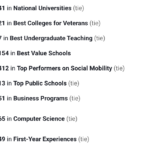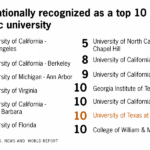US News university rankings significantly influence prospective students and universities alike. This analysis delves into the methodology behind these influential rankings, exploring the factors considered, their impact on university placement, and the inherent criticisms leveled against the system. We will examine the weighting of various factors, compare the US News methodology to other ranking systems, and discuss the broader implications of these rankings on higher education.
Understanding the intricacies of the US News ranking system is crucial for navigating the complex landscape of higher education. From the weighting of research output and faculty resources to the role of student selectivity and financial endowments, we will unpack the elements that contribute to a university’s overall score. Furthermore, we’ll explore the limitations and biases associated with these rankings, highlighting the importance of considering alternative evaluation methods.
Impact of Ranking Factors on University Placement
University rankings, while often debated, significantly influence prospective students, faculty recruitment, and institutional funding. Understanding the key factors driving these rankings is crucial for both institutions and those seeking higher education. These rankings are not simply arbitrary; they reflect a complex interplay of various metrics, each contributing to a university’s overall standing.
Research Output’s Influence on University Ranking
Research output is a cornerstone of many university ranking systems. High-impact publications in prestigious journals, significant research grants secured, and the overall volume of research activity all contribute substantially to a university’s score. Universities with strong research programs often attract top faculty and students, fostering a virtuous cycle of excellence. For example, institutions like MIT and Stanford consistently rank highly, in part due to their immense research output and the resulting high citation rates of their published work. The sheer number of patents filed and licensed also indicates a strong research ecosystem, further boosting their ranking positions. A strong emphasis on interdisciplinary research, leading to innovative breakthroughs, is also a key factor.
Faculty Resources’ Effect on University Placement
The quality and resources available to faculty are another critical determinant of university ranking. This encompasses factors such as faculty-to-student ratios, the number of endowed professorships, and the average research funding per faculty member. A low student-to-faculty ratio often signifies a more personalized learning environment and greater access to mentorship opportunities, which are attractive to both students and faculty. Universities with substantial endowed professorships demonstrate a commitment to attracting and retaining leading researchers, contributing to their overall prestige. For instance, institutions like Harvard and Oxford, renowned for their extensive endowments and esteemed faculty, consistently achieve top rankings. Their ability to attract and retain leading scholars reflects positively on their overall academic strength.
Student Selectivity’s Role in Determining Rankings, Us news university ranking
Student selectivity, often measured by acceptance rates and the academic credentials of incoming students, plays a significant role in university rankings. A highly selective admissions process suggests that the university attracts top students, contributing to a vibrant and competitive academic environment. This is reflected in metrics like average SAT/ACT scores and the percentage of students graduating in the top 10% of their high school classes. The competitiveness of the applicant pool, as reflected in these metrics, is a key indicator of institutional prestige and quality. Universities such as Caltech and Princeton, known for their extremely selective admissions, consistently place highly in global rankings, largely due to the high caliber of their student body.
The Role of Financial Resources in Rankings
University rankings are significantly influenced by financial resources, creating a complex interplay between wealth and academic standing. A university’s endowment size, research funding, and overall financial health directly impact its ability to attract top faculty, support student services, and invest in cutting-edge facilities, all of which are key factors considered in ranking methodologies.
The correlation between a university’s endowment size and its ranking is generally positive, though not always perfectly linear. Larger endowments provide a substantial financial cushion, enabling institutions to invest in various areas that enhance their academic reputation and attract high-achieving students and faculty. This financial stability allows for strategic planning and long-term investments that might be impossible for universities with more limited resources.
Financial Resources and Research Opportunities
Access to substantial funding is crucial for fostering a vibrant research environment. Larger endowments allow universities to invest in state-of-the-art research facilities, equipment, and technology. This, in turn, attracts leading researchers and provides ample opportunities for graduate students to engage in cutting-edge research projects. Furthermore, robust financial resources facilitate the securing of external grants and contracts, further fueling research activities and enhancing the university’s overall research output, a key component of many ranking systems. The availability of research funds directly correlates with the quantity and quality of publications produced by the university’s faculty and students.
Financial Resources and Faculty Recruitment
Competitive salaries and benefits packages are essential for attracting and retaining top-tier faculty. Universities with substantial endowments can offer more attractive compensation packages, making them more desirable employers for renowned professors and researchers. This competitive edge is particularly crucial in attracting faculty in high-demand fields where competition for talent is fierce. Beyond salaries, endowments can support faculty development initiatives, research grants, and the provision of resources needed to conduct impactful research, ultimately boosting the university’s overall academic standing.
Financial Resources and Student Support Services and Facilities
Financial resources play a vital role in providing comprehensive student support services and modern facilities. Well-funded universities can invest in state-of-the-art libraries, technology infrastructure, athletic facilities, and student housing. They can also provide more extensive financial aid packages, career services, academic advising, and mental health support for students. These resources significantly improve the overall student experience and contribute to higher student satisfaction rates, which are often indirectly reflected in university rankings. Improved facilities and robust support systems also enhance the overall learning environment and contribute to better student outcomes.
Comparative Example: Harvard University and a Smaller Public University
Harvard University, with its multi-billion dollar endowment, exemplifies the impact of substantial financial resources on university ranking. Its vast endowment allows for significant investments in research, faculty recruitment, and student support. In contrast, a smaller public university with a significantly smaller endowment might face limitations in attracting top faculty, offering competitive salaries, and providing the same level of student support services and state-of-the-art facilities. This disparity in financial resources directly translates into differences in research output, faculty quality, and overall academic standing, ultimately impacting their respective positions in university rankings. The difference in resources is clearly reflected in the significant gap in their overall ranking positions.
Influence of Alumni Networks on Rankings
A university’s ranking isn’t solely determined by academic prowess; a robust and engaged alumni network significantly contributes to a university’s overall reputation and, consequently, its standing in national and international rankings. The strength of these networks reflects the institution’s long-term success in fostering meaningful relationships with its graduates, impacting various aspects of the university’s operations and public perception.
Alumni networks bolster a university’s reputation and influence in several key ways. A strong alumni network translates directly into enhanced prestige and visibility. Successful alumni often become prominent figures in their fields, associating their achievements with their alma mater, thus indirectly promoting the university’s reputation. This positive association influences prospective students and faculty, enhancing the university’s attractiveness and competitiveness.
Alumni Support and University Resources
Alumni contributions are crucial to a university’s financial stability and ability to invest in its resources. These contributions take various forms, including direct donations, endowments, scholarships, and even mentorship opportunities for current students. Significant financial support from alumni allows universities to enhance their facilities, attract top faculty, and offer more scholarships, all factors considered in university rankings. For example, Stanford University’s substantial endowment, largely fueled by alumni donations, allows it to maintain its high standards and attract leading researchers and scholars. This financial strength directly impacts its consistently high ranking.
Alumni Engagement and Student Recruitment
Engaged alumni play a vital role in attracting prospective students. Alumni often participate in recruitment events, offering insights into their career paths and experiences, thereby influencing prospective students’ decisions. Their testimonials and connections can provide invaluable perspectives for prospective students, strengthening the university’s appeal. Universities actively cultivate alumni engagement through networking events, mentorship programs, and online platforms, recognizing the crucial role alumni play in recruitment efforts. This proactive approach contributes to increased student applications and ultimately, higher rankings.
Examples of Universities with Highly Influential Alumni Networks
Several universities exemplify the power of strong alumni networks. Harvard University boasts a vast and influential network of alumni, including numerous Nobel laureates, business leaders, and political figures. Their contributions significantly impact the university’s resources and reputation. Similarly, the University of Oxford’s global alumni network spans centuries, consistently contributing to the university’s prestige and influence. These alumni actively support the university, enriching its academic and research endeavors. The extensive and well-organized alumni networks of these institutions significantly contribute to their consistent high rankings in global university evaluations.
Ethical Considerations of University Rankings: Us News University Ranking
University rankings, while providing valuable information for prospective students and researchers, raise significant ethical concerns. The inherent complexities of comparing institutions across diverse missions and contexts, coupled with the potential for manipulation, necessitate a critical examination of their ethical implications. The influence of these rankings on institutional decision-making, funding allocation, and public perception demands a responsible and transparent approach.
The use of rankings for university evaluation presents several ethical dilemmas. Overemphasis on ranking metrics can incentivize institutions to prioritize those factors measured in the rankings, potentially at the expense of other equally important aspects of higher education, such as teaching quality, student well-being, and research ethics. This can lead to a distortion of institutional priorities and a narrowing of the educational experience. Furthermore, the methodologies employed by different ranking organizations often vary significantly, leading to inconsistencies and a lack of comparability between rankings.
Potential for Manipulation of Ranking Metrics
The pressure to achieve high rankings can tempt universities to engage in practices that artificially inflate their scores. This might involve strategic recruitment of high-achieving students, selective reporting of research output, or manipulating the data submitted to ranking agencies. For example, an institution might focus heavily on increasing its research output measured by citations, even if that research lacks broader impact or significance. Similarly, a university could prioritize attracting students with high standardized test scores, neglecting those with diverse backgrounds or unique talents. Such practices undermine the integrity of the ranking systems and distort the true picture of institutional performance.
Importance of Transparency and Accountability in Ranking Systems
Transparency and accountability are crucial for mitigating the ethical challenges associated with university rankings. Ranking organizations should clearly articulate their methodologies, including the weighting of different metrics and the data sources used. This allows for greater scrutiny and helps identify potential biases or flaws in the ranking process. Furthermore, universities should be held accountable for the accuracy and integrity of the data they submit. Independent audits or verification processes could help ensure the reliability of the information used in rankings. Open access to the data used in rankings would also promote greater transparency and allow for independent analysis.
Recommendations for Improving the Ethical Aspects of University Rankings
Improving the ethical aspects of university rankings requires a multi-faceted approach involving ranking organizations, universities, and policymakers. A critical first step is to broaden the range of metrics considered, moving beyond a narrow focus on easily quantifiable measures. Incorporating qualitative assessments of teaching quality, student experience, and institutional commitment to social responsibility would provide a more holistic picture of university performance.
- Develop more robust and transparent methodologies for ranking universities, ensuring that the metrics used accurately reflect the diverse missions and contexts of different institutions.
- Implement stricter regulations to prevent universities from manipulating ranking metrics through unethical practices.
- Promote greater collaboration between ranking organizations and universities to ensure the accuracy and integrity of the data used in rankings.
- Encourage the development of alternative evaluation frameworks that go beyond simple numerical rankings and incorporate qualitative assessments of institutional performance.
- Foster greater public awareness of the limitations and potential biases of university rankings, empowering students and policymakers to make informed decisions.
Ultimately, the US News university rankings, while influential, represent only one perspective in the multifaceted evaluation of higher education institutions. A holistic approach, considering diverse ranking systems, qualitative factors, and individual student needs, is essential for making informed decisions about university selection. Understanding the methodology, limitations, and broader context surrounding these rankings empowers both students and institutions to navigate the landscape of higher education with greater clarity and insight.
US News university rankings are a significant factor for prospective students, offering a snapshot of institutional prestige and academic strength. A prime example of this is found when examining the detailed analysis provided by Rice University US News Rankings & , showcasing its consistent high placement. Understanding these rankings allows students to effectively compare universities and make informed decisions about their higher education journeys.
US News university rankings often influence prospective students’ choices, highlighting institutions with strong academic reputations. Staying informed about individual university updates is crucial; for instance, you can find recent developments at Monmouth University by checking out their news section, Monmouth University News Recent Updates. These updates can significantly impact a university’s standing in future US News rankings.





